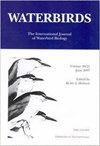加拿大东部北方森林水电站蓄水池养殖水禽的蓄水前后研究
IF 0.6
4区 生物学
Q3 ORNITHOLOGY
引用次数: 1
摘要
水力蓄水池的蓄水极大地改变了水禽的栖息地,因为它涉及到将一条湍急的河流、它的支流以及附近的池塘和湿地变成一个大水体。采用“控制-影响前-控制-后”设计,评估了psamribonka水库的建设是否影响了该地区水禽繁殖对和雏禽的丰度和物种组成。psamribonka水库是一个坡度大、水位波动小的水电站。我们使用了基于直升机的水鸟调查数据,涵盖了水库建成前2年和建成后10年的时间。我们还使用了9个5 × 5 km的样地和72 km的河流作为对照点。结果表明:养殖对密度在蓄水后略有增加,而产卵密度显著增加(增加了6倍),特别是黄眼(Bucephala clangula);这表明,可能由于低水位波动和局部浅水地区,蓄水后水禽的栖息地得到了有利的增加,缓解措施可能有助于减少该项目的影响。由于这项BACI研究在蓄水10年后结束,因此很难确定pembroribonka水库的情况是否已经稳定或仍在发展。本文章由计算机程序翻译,如有差异,请以英文原文为准。
Pre- and Post-Impoundment Study of Breeding Waterfowl Use of a Hydroelectric Reservoir in the Eastern Canadian Boreal Forest
Impoundment of hydroelectric reservoirs deeply modifies habitats available for waterfowl because it involves transforming a fast-flowing river, its tributaries and nearby ponds and wetlands into a large body of water. Using a Before-After-Control-Impact design, we evaluated whether the creation of the Péribonka reservoir, a steep-sloped hydroelectric reservoir with low water level fluctuations, affected the abundance and species composition of waterfowl breeding pairs and broods in the area. We used helicopter-based waterfowl survey data covering a period of 2 years before and a period of 10 years after the creation of the reservoir. We also used 9 5x5 km plots and 72 km of river as control sites. Our results show that breeding pair density slightly increased after impoundment, while brood density increased significantly (sixfold), especially for Common Goldeneye (Bucephala clangula). This suggests that there were favorable habitat gains for waterfowl after impoundment, probably due to low water level fluctuations and localized areas of shallow water, and that mitigation measures likely helped to reduce the impact of the project. Because this BACI study ended 10 years after impoundment, it remains difficult to ascertain whether conditions in the Péribonka reservoir have stabilized or are still evolving.
求助全文
通过发布文献求助,成功后即可免费获取论文全文。
去求助
来源期刊

Waterbirds
生物-鸟类学
CiteScore
1.30
自引率
0.00%
发文量
0
审稿时长
6-12 weeks
期刊介绍:
Waterbirds is an international scientific journal of the Waterbird Society. The journal is published four times a year (March, June, September and December) and specializes in the biology, abundance, ecology, management and conservation of all waterbird species living in marine, estuarine and freshwater habitats. Waterbirds welcomes submission of scientific articles and notes containing the results of original studies worldwide, unsolicited critical commentary and reviews of appropriate topics.
 求助内容:
求助内容: 应助结果提醒方式:
应助结果提醒方式:


